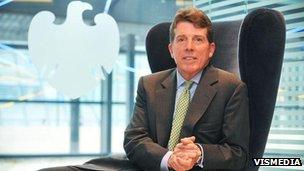Barclays 'attempted to manipulate interest rates'
- Published
- comments
Barclays fined £290m for attempts to manipulate key bank rates
In its £290m settlement with the Financial Services Authority in the UK, and the Commodity Futures Trading Commission and Department of Justice in the US, Barclays has owned up to something very simple and - many would say - profoundly shocking: for four years between 2005 and 2009, it lied about the interest rate it was having to pay to borrow.
Here is today's statement from the CFTC:
"Barclays….attempted to manipulate and made false reports concerning both benchmark interest rates to benefit the bank's derivatives trading positions by either increasing its profits or minimizing its losses. The conduct occurred regularly and was pervasive."
The CFTC also says that after the start of the credit crunch in August 2007, all the way through to early 2009, Barclays made "artificially low…submissions" about the interest rate it was being forced to pay to borrow to "protect Barclays' reputation from negative market and media perceptions concerning Barclays' financial condition".
This was done, according to the CFTC, "as a result of instructions from Barclays' senior management".
In other words, Barclays was pretending that it could borrow more cheaply than was actually the case, to reassure its owners and creditors that lenders had more confidence in it than was true.
Libors and Euribors: What are they?
At the heart of the scandal are market interest rates called Libor and Euribor. These are the interest rates that are supposed to show the average price paid by banks when lending to each other or borrowing from each other.

Barcalys Chief Executive Bob Diamond has waived his bonus for 2012
Their most important role, perhaps, is in setting the prices for complicated financial transactions called derivatives. Here is one example of why these rates matter, in the words of the CFTC: "US dollar Libor is the basis for the settlement of the three-month Eurodollar futures contract traded on the Chicago Mercantile Exchange, which had a traded volume in 2011 with a notional value exceeding $564 trillion."
In other words, just the dollar version of Libor sets the price for deals with a notional value equal to nine times global economic output or GDP. And that is just a small fraction of the market that is influenced by Libor and Euribor rates.
To put it another way, a tiny difference in the Libor or Euribor rate could determine whether a bank like Barclays - and other banks - would make a profit or a loss on huge derivatives deals. So there was a massive incentive to try and manipulate that rate.
Now to be clear, the CFTC is explicit that other banks were at it too. It says: "Certain Barclays Euro swaps traders, led at the time by a senior trader, coordinated with and aided and abetted traders at other banks in each other's attempt to manipulate Euribor, even scheming to impact Euribor on key standardised dates when many derivatives contracts are settled or reset."
The FSA and CFTC quote from emails written by Barclays' traders to their counterparts at these other banks who were requesting this help in rigging markets. The responses included "always happy to help", "for you, anything" and "done… for you big boy".
Or to put it another way, it is widely expected that other big international banks will pay big fines and penalties in connection with this scandal.
As for Barclays, its top executives are mortified. The four most senior, led by Bob Diamond, the chief executive, are waiving their bonuses. And disciplinary action has been taken and is being taken against traders in New York, London and Tokyo who committed the offences.
But perhaps what is most important about all of this is that it is another shattering blow to the reputation of the banking industry, at a time when that reputation - many would say - is already at rock bottom.